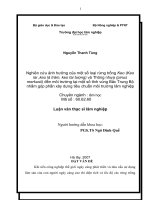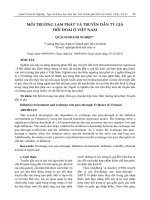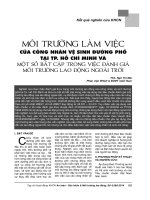Môi trường làm việc với vai trò là yếu tố thúc đẩy việc tự hoàn thiện tiếng Anh trường hợp các dự án của CARE quốc tế tại Việt Nam
Bạn đang xem bản rút gọn của tài liệu. Xem và tải ngay bản đầy đủ của tài liệu tại đây (962.55 KB, 79 trang )
VIETNAM NATIONAL UNIVERSITY, HANOI
UNIVERSITY OF LANGUAGES AND INTERNATIONAL STUDIES
POSTGRADUATE DEPARTMENT
VŨ MAI GIANG
WORK ENVIRONMENT AS A MOTIVATING FACTOR
FOR SELF-IMPROVEMENT OF ENGLISH:
A CASE STUDY OF PROJECTS IN
CARE INTERNATIONAL IN VIETNAM
MÔI TRƯỜNG LÀM VIỆC VỚI VAI TRÒ LÀ YẾU TỐ THÚC ĐẨY
VIỆC TỰ HOÀN THIỆN TIẾNG ANH:
TRƯỜNG HỢP CÁC DỰ ÁN CỦA CARE QUỐC TẾ TẠI VIỆT NAM
MA THESIS
Major: English Teaching Methodology
Code: 60.14.10
HANOI, 2009
VIETNAM NATIONAL UNIVERSITY, HANOI
UNIVERSITY OF LANGUAGES AND INTERNATIONAL STUDIES
POSTGRADUATE DEPARTMENT
VŨ MAI GIANG
WORK ENVIRONMENT AS A MOTIVATING FACTOR
FOR SELF-IMPROVEMENT OF ENGLISH:
A CASE STUDY OF PROJECTS IN
CARE INTERNATIONAL IN VIETNAM
MÔI TRƯỜNG LÀM VIỆC VỚI VAI TRÒ LÀ YẾU TỐ THÚC ĐẨY
VIỆC TỰ HOÀN THIỆN TIẾNG ANH:
TRƯỜNG HỢP CÁC DỰ ÁN CỦA CARE QUỐC TẾ TẠI VIỆT NAM
MA THESIS
Major: English Teaching Methodology
Code: 60.14.10
Supervisor: Dr. Tô Thị Thu Hương
HANOI, 2009
iii
TABLE OF CONTENTS
CHAPTER 1: INTRODUCTION
1
1.1 Rationale of the study
1
1.2 Scope and purposes of the study
2
1.3 Research Questions
2
1.4 Significance of the study
3
1.5 Methodology
3
1.6 Study design
3
1.7 Definition of terms
4
CHAPTER 2: LITERATURE REVIEW
5
2.1 Motivation Theories
5
2.1.1 What is motivation?
5
2.1.2 Different approaches towards motivation in language learning
7
2.1.3 Different approaches towards motivation at work
9
2.1.4 Role of motivation
13
2.1.5 Types of motivation
15
2.1.6 Factors affecting motivation in L2 learning
18
2.2 Work environment in language learning
20
2.2.1 Language learning environment
20
2.2.2 What is meant by work environment?
22
2.2.3. Role of work environment to learning
23
2.2.4. Factors affecting learning at workplace
24
CHAPTER 3: METHODOLOGY
26
3.1 Context of the study
26
3.1.1 An overview of CARE International in Vietnam
26
3.1.2 Work Environment in CARE
27
3.2 Methodology
28
3.2.1 Case study
28
3.2.2 Validity and reliability
30
3.3 Data collection
31
iv
3.3.1 Questionnaire
31
3.3.2 Semi-structured interviews
32
CHAPTER 4: DATA ANALYSIS AND FINDINGS
34
4.1 Participants’ general information
34
4.2 Types of motivation for English self-improvement possessed by CARE
Vietnamese staff
37
4.3. Motivating role of work environment in CARE Vietnamese staff’s self-
improvement of English
40
4.4 Elements of work environment affecting CARE staff‘s motivation to self-
improve their English
45
4.4.1 Work requirements
46
4.4.2 Relationships in CARE
48
4.4.3 Opportunities
50
4.4.4 Other elements
52
4.5 Discussion
54
CHAPTER 5: CONCLUSION
55
5.1 Summary of major findings
55
5.2 Recommendations
56
5.3 Future directions
58
REFERENCES
59
APPENDIX 1
(Survey questionnaire for CARE Vietnamese staff in English and Vietnamese)
APPENDIX 2
(Guidelines for in-depth interviews in Vietnamese)
v
List of graphs and tables for data analysis
Graph 1: English language skills before and after working for CARE
Graph 2: Role of CARE work environment in self-improvement of English
Table 1: Participants’ profile
Table 2: Types of motivation for English self-improvement possessed by CARE staff
Table 3: Work requirements in CARE
Table 4: Kind of work that CARE staff have to use English and their frequency
Table 5: Relationships in CARE
Table 6: Opportunities of working for CARE
1
CHAPTER 1: INTRODUCTION
1.1 Rationale of the study
Since Vietnam started its “Doi moi” process, much attention has been paid to
learning how to use English for communication. It has become the main foreign language
in schools, the language at work environment and for diplomacy. It is a fact that English
teaching centres have mushroomed, learners rush out to evening English classes with a
hope to gain better marks in the exams and get a good job. Even busy adults spend their
limited time on learning English to better perform tasks, to get promoted, to find a better
job in an English speaking environment or to study abroad. Motivation to learn English,
hence, becomes more important than ever because it is the key factor affecting the success
or failure in language learning process.
Also since Vietnam opened its door to the outside world, more and more non-
governmental organisations (NGOs) establish their representative offices in Vietnam and
thousands of projects have been implemented for Vietnam’s sustainable development.
More and more Vietnamese come to work for an NGO and often enjoy the work
environment there. NGO environment is usually a multi-cultural, multi-lingual one where
English is mainly used for communication. One question is raised: Can Vietnamese staff
improve their English in such an environment and if so, how to improve?
Many studies have been conducted on English learning and teaching and many
techniques have been suggested for brushing up one’s English. Though there are some
studies focusing on the motivation to study English and how to maintain and strengthen
such motivation at school and colleges, there are few or no studies on learning English and
motivation to learn English after leaving colleges.
It is quite common that some English major graduates often complain that their
English skills get worse after graduation because they do not have the environment to use
it, their work does not require them to use English and they also do not have time for
further learning. Some non-major graduates state that they want and they need to improve
2
their English but they do not have an appropriate environment to learn and to use the
language. In all these circumstances, the work environment plays a crucial role in
determining whether employees have strong and long-lasting motivation to self-improve
their English.
With the above mentioned reasons, the researcher would like to investigate English
learning in an NGO environment and the role of work environment in motivating staff to
improve their English. It is hoped that the research would be of great help for those
working in an NGO in particular and elsewhere in general.
1.2 Scope and purposes of the study
The study was conducted on the Vietnamese staff who are currently working for
different projects in CARE International in Vietnam (hereafter abbreviated as CARE). The
study mainly focused on the principal purposes below:
to explore different types of motivation possessed by CARE Vietnamese staff for self-
improvement of their English skills;
to identify their perceptions of the role of work environment in their English self-
improvement;
to investigate the main elements affecting their English self-improvement in an NGO
setting.
1.3 Research Questions
In order to achieve the three principal purposes of the study, respectively there are
three research questions as follows:
1) What are the types of motivation for self-improvement of English possessed by CARE
Vietnamese staff?
2) How motivating do CARE staff find the work environment for their self-improvement of
English?
3) What elements in the work environment mainly motivate them to self-improve their
English?
3
1.4 Significance of the study
Much research has shown the importance of social contexts or learning
environments on second language learning. This study was carried out with the hope to
provide language learners, especially those who work for an NGO with an overview of the
role of work environment and its elements affecting their motivation to self-improve their
English. It is hoped that, the findings from this study will make managers better understand
their staff and hence, create more favourable opportunities for their staff learning in
general and for their English learning in particular.
This study will not only help those working in CARE to reflect on their self-
improvement of English but also help English learners to be aware of and make best use of
their work environment in their path to English perfection. In the broader term, the study
also might be useful for the organisations to make the strategic plan for human resource
development and give an insight to informal learning at workplace.
1.5 Methodology
In order to achieve the primary purposes of the study – to discover CARE
Vietnamese staff’s motivation types for English self-improvement, to get their opinions
about the role of the work environment and its elements affecting their motivation for self-
improvement of English, the case study was adopted in this study.
This case study uses both qualitative and quantitative approach with questionnaire
and semi-structured interviews as the main data collection tools for the given purpose to
get an insight into CARE’s staff motivation to self-improve English at workplace. The
instruments as well as the data collection process will be discussed in more details in
Chapter 3.
1.6 Study design
The study consists of five chapters as follows:
4
Chapter 1 provides a general introduction including the rationale, the scope and
purposes, research questions, significance, methodology and design of the study.
Definitions of terms are also presented in this chapter.
Chapter 2 aims at systematizing the theoretical background for the thesis by
discussing the two main points: motivation theories and approaches in language learning as
well as at work environment and the impact of work environment in language learning.
Chapter 3 focuses on the research methodology, explaining why case study was
chosen for the conduct the research as well as how to achieve reliability and validity. It
also describes the tools and procedures to collect data.
Chapter 4 presents the data analysis and findings. In this chapter, a comprehensive
analysis and interpretation of the collected data will be explored to find the answers to the
research questions.
Chapter 5 is the conclusion of the study, providing a summary of major findings,
recommendations as well as directions for further research.
1.7 Definition of terms
Self-improvement: increasing the ability of using the four English macro-skills
consciously and subconsciously (learning and acquisition)
Motivation: some kind of internal drive that encourages somebody to pursue a
course of action (Harmer 1983)
Target language: the language which a person is learning other than his/her mother
tongue.
Second language (L2): refers to a target language that learners aim to master. The
L2 in this study refers to English.
Language acquisition: refers to a subconscious process of picking up a language
through exposure
Learning environment: refers to the physical, mental and social conditions at the
learner’s disposal.
Work environment: means the social and professional setting around a person in
which s/he is supposed to interact with peers and supervisors.
5
CHAPTER 2: LITERATURE REVIEW
The important role of motivation in second language learning is undeniable and
motivation can be consider the key to successful L2 learning. Thus, much research on
motivation and its role in second language acquisition has been undertaken so far.
Motivation is influenced by social and situational contexts so it needs to be examined in
the surrounding settings. In this chapter, the researcher shall review some theories on
motivation as well as the work environment as the theoretical backgrounds for the study.
2.1 Motivation Theories
2.1.1 What is motivation?
The concept of motivation is very much part of our personal and professional life.
In our everyday conversation, we talk about likes and dislikes, wishes and desires, attitudes
towards, for example, English learning. At work, we may complain about the salary, the
incompetent management, the relationship with colleagues or supervisors, opportunities for
promotion or study further. All these things belong to motivation, a domain attracting
much study and research because of its enabling power.
According to Brown (2002), “Motivation is one of the most important factors in the
success in English. Motivation means having a real purpose in learning English, or really
wanting to learn English for a reason”.
Motivation, defined as the impetus to create and sustain intentions and goal-seeking
acts (Ames & Ames, 1989), is important because it determines the extent of the learner's
active involvement and attitude toward learning. It is learners’ orientation toward the goal
of learning a second language (Crookes and Schmidt 1991).
The Longman Dictionary of Language Teaching and Applied Linguistics defines
motivation as follows:
6
Motivation is generally considered to be one of the primary causes of success and
failure in second language learning (2002: 344).
So it would seem, from this definition that motivation is something we need to take
seriously into consideration if we are concerned about creating the best possible L2
acquisition.
Gardner (1985) indicated that the motivation of foreign language learning contains
four aspects:
- A goal,
- Effortful behavior,
- A desire to attain the goal,
- Attitude towards the activity.
Motivation then refers to the combination of desire and effort to conduct a behaviour to
achieve a goal.
Moore (1997) defined motivation as the forces or drives that energize and direct us
to act as we do. Motivation leads to accomplishments. We plan for them, work for them
and achieve them based on our short-term and long-term goals.
Though much research has been conducted on motivation, there is still a debate on
what motivation truly is. “If motivation were a straightforward concept it would be
uninteresting” (Galloway et al, 1998:42).
According to Lightbown & Spada, motivation in second language learning is a
complex phenomenon which can be defined in terms of two factors: learners’
communicative needs and their attitudes towards the second language community. If
learners need to speak the second language in social situations to fulfill professional
ambitions or if they have favourable attitudes towards the speakers of the language, they
will be motivated to acquire that language proficiency.
Perhaps the only thing about motivation most researchers would agree on is that it,
by definition, concerns the direction and magnitude of human behaviour that is:
7
- the choice of a particular action
- the persistance with it
- the effort expended on it
In other words, motivation is responsible for:
- why people decide to do something,
- how long they are willing to sustain the activity
- how hard they are going to pursue it
(Cited in Dornyei, 2001:8)
2.1.2 Different approaches towards motivation in language learning
One explanation for the complex meaning of the term “motivation” is that there are
many different approaches towards motivation research. In this section, we will discuss
three major approaches that are the most helpful to the study: the behaviourist, the
cognitive and the constructivist approaches.
Most early theories on motivation were based on a behaviourist approach.
Motivation is quite simply “the anticipation of reward”. Driven to acquire positive
reinforcement, and driven by previous experiences of reward for behaviour, we act
accordingly to achieve further reinforcement. Behaviourists consider performance in tasks
and motivation to do so, results from external forces: parents, teachers, peers, educational
requirements, job specifications, and so forth (Brown 2007). This approach, however,
cannot satisfactorily explain the complex behaviours of human beings.
From the cognitive view, motivation places more emphasis on the individual’s
decision, “the choices people make as to what experiences or goals they will approach or
avoid, and the degree of effort they will exert in that respect” (Keller, 1983). Ausubel
(1968, cited in Brown 2007) identified six needs for the construct of motivation:
- The need for exploration, for seeing the other side of the mountain
- The need for manipulation, for operating on the environment and causing change
- The need for activity, for both mental and physical movement
8
- The need for stimulation, the need to be stimulated by the environment, by other
people, or by ideas, feelings, thoughts
- The need for knowledge
- The need for ego enhancement, for the self to be known and to be accepted and
approved of by others.
A constructivist view of motivation places even further emphasis on social context
as well as individual personal choices. According to Williams and Burden (1997), a
constructivist view of motivation centres around the premise that each individual is
motivated differently… however, an individual‘s motivation is also subject to social and
contextual influences. These will include the whole culture and context and the social
situation, as well as significant other people and the individual’s interaction with these
people. (Cited from Dornyei 2001:115)
William and Burden’s framework of L2 motivation (cited from Dornyei 2001)
Internal factors
Intrinsic interest of activity:
- arousal of curiosity
- optimal degree of challenge
Perceived value of activity:
- personal relevance
- anticipated value of outcomes
- intrinsic value attributed to the
activity
Sense of agency:
- locus of causality
- locus of control RE process and
outcomes
- ability to set appropriate goals
Mastery:
- feelings of competence
External factors
Significant others:
- parents
- teachers
- peers
The nature of interaction with significant
others:
- mediated learning experiences
- the nature and amount of feedback
- rewards
- the nature and amount of
appropriate praise
- punishments, sanctions
The learning environment:
- comfort
- resources
9
- awareness of developing skills and
mastery in a chosen area
- self-efficacy
Self-concept:
- realistic awareness of personal
strengths and weaknesses in skills
required
- personal definitions and judgements
of success and failure
- self-worth concern
- learned helplessness
Attitudes:
- to language learning in general
- to the target language
- to the target language community
and culture
Other affective states:
- confidence
- anxiety, fear
Developmental age and stage
Gender
- time of day, week, year
- size of class and school
- class and school ethos
The broader context:
- wider family networks
- the local education system
- conflicting interests
- cultural norms
- societal expectations and attitudes
In short, the behaviourist approach and the cognitive view, when looking at
motivation, either focus on the external forces or the individuals’ decision. Hence, they
both get stuck in seeking explanations for human beings’ complicated behaviours. In order
to solve the problem, the constructivist approach was born, combining the personal choice
and the environment that a person is living in, to have a more appropriate look at
motivation.
2.1.3 Different approaches towards motivation at work
Understanding what motivated employees and how they were motivated was the
focus of many researchers. Five major approaches that have led to our understanding of
10
motivation at work are Maslow’s need-hierarchy theory, Herzberg's two- factor theory,
Vroom's expectancy theory, Adams' equity theory, and Skinner's reinforcement theory.
According to Maslow, employees have five levels of needs (Maslow, 1943):
physiological, safety, social, ego, and self- actualizing.
Maslow argued that lower level needs had to be satisfied before the next higher
level need would motivate employees, for example once the physiological needs like food
and shelter are met, people move up the hierarchy and become motivated by security
issues. Maslow's theory does tell us two important things:
- That not all people are motivated by the same thing.
- That the same person is not always motivated by the same thing since their needs
change over time.
Herzberg's work categorized motivation into two factors: motivators and hygienes
(Herzberg, Mausner, & Snyderman, 1959). Motivator or intrinsic factors, such as
achievement and recognition, produce job satisfaction. Hygiene or extrinsic factors, such
as pay and job security, produce job dissatisfaction.
11
Motivator factors, increase job
satisfaction:
- Achievement
- Recognition
- Work itself
- Responsibility
- Advancement
- Growth
Hygiene factors, those whose absence can
create job dissatisfaction:
- Supervision
- Company policy
- Working conditions
- Salary
- Peer relationship
- Security
Herzberg interviewed thousands of workers to determine what really motivates
them on the job. He listed the factors that influence motivation as follows:
1. Sense of Achievement
2. Earned Recognition
3. Interest in the Work Itself
4. Opportunity for Growth
5. Opportunity for Advancement
6. Importance & Responsibility
7. Peer & Group Relationships
8. Salary (Pay)
9. Fairness of Supervisors
10. Company Policy & Rules
11. Status & Perks
12
12. Job Security
13. Friendliness of Supervisor
14. Working Conditions
Some of these factors of work environment have been found to influence CARE
Vietnamese staff’s motivation to self-improve their English such as: peer relationship,
opportunities, work requirements, and will be discussed in chapter 4.
Vroom's theory is based on the belief that employee effort will lead to performance
and performance will lead to rewards (Vroom, 1964). Rewards may be either positive or
negative. The more positive the reward the more likely the employee will be highly
motivated. Conversely, the more negative the reward the less likely the employee will be
motivated.
Unlike Maslow and Herzberg, Vroom does not concentrate on needs, but rather
focuses on outcomes. Whereas Maslow and Herzberg look at the relationship between
internal needs and the resulting effort expended to fulfils them, Vroom separates effort
(which arises from motivation), performance, and outcomes. Vroom, hypothesizes that
effort, performance and motivation must be linked so that a person is motivated. He
proposes three variables to account for this, which he calls Valence, Expectancy and
Instrumentality. Expectancy is the belief that increased effort will lead to increased
performance i.e. if I work harder then this will be better. Instrumentality is the belief that if
I perform well that a valued outcome will be received i.e. if I do a good job, there is
something in it for me. Valence is the importance that the individual places upon the
expected outcome. For example, if I am mainly motivated by money, I might not value
offers of additional time off.
Adams’ theory states that employees strive for a fair balance between an
employee’s inputs (hard work, skill level, tolerance, enthusiasm, etc.) and an employee’s
outputs (salary, benefits, intangibles such as recognition, etc.) as well as the equity
between themselves and other workers. According to the theory, finding this fair balance
13
serves to ensure a strong and productive relationship is achieved with the employee, with
the overall result being contented, motivated employees.
Skinner's theory simply states those employees' behaviors that lead to positive
outcomes will be repeated and behaviors that lead to negative outcomes will not be
repeated (Skinner, 1953). Managers should positively reinforce employee behaviors that
lead to positive outcomes.
These five major approaches give us an overview of the things that influence
employees’ motivation such as needs to be satisfied, the work itself, peer and group
relationship, supervision, treatment among employees and reinforcement of behaviours.
Employers should take these into account in order to have content and motivated
employees, who will then contribute to the organisation development.
2.1.4 Role of motivation
Attitudes and motivational factors have been shown to play a crucial role in second
and foreign language learning. Gardner and Lambert (1972) indicate that affective factors,
including attitudes and motivation, have significant relationship with foreign language
achievement. In fact, these studies have shown that independently of their language
aptitude, learners who are highly motivated and have positive attitudes toward the target
language are more likely to do well in learning a second or foreign language than learners
who are less highly motivated or who have negative attitudes.
The table below presents a brief summary of some findings about the important
role of motivation in language learning.
Table: Some Findings Concerning Role of Motivation in Second Language Acquisition
(adapted from Gardner 2001)
Reference Finding
14
Gardner & Smythe (1981) Integrativeness, Attitudes toward the Learning
Situation, and Motivation are separate but correlated
constructs, and Motivation has a direct effect on
second language achievement.
Clément, Smythe Differences in integrative motivation help to
& Gardner (1978) explain who will drop out and who will continue with
language study in future years.
Gliksman, Gardner, Differences in integrative motivation account
& Smythe (1982) for differences in activity in the language classroom.
Desrochers & Gardner (1981) Differences in motivation are related to whether or
not children will participate in school-planned
excursions to the other language community.
Gardner & Lysynchuk (1990) Motivation promotes the retention of second
language skills after study ends, largely because
motivated individuals will tend to use the language
during the subsequent period.
Tremblay, Goldberg Levels of trait (i.e., long lasting) motivation to
& Gardner (1985) learn second languages influence levels of state (i.e.,
at the moment) motivation which in turn influence
the rate of learning second-language vocabulary.
Gardner & MacIntyre (1991) Both integrative and instrumental motivation
influence the rate of learning second language
vocabulary.
15
The relationship between language learning and motivation is an interactive one
though, since many research findings show that successful learning can enhance
motivation and vice versa. As Gardner and Smythe (1981) claim that high correlation
between motivation and successful learning confirms the importance of motivation
whether learners arrive with it or acquire it through successful learning experience.
2.1.5 Types of motivation
Based on the reasons for learning a language, motivation is classified into different
types including:
Integrative motivation
Gardner and Lambert (1972) described learners with an integrative orientation are
those who wish to integrate themselves into the culture of the second language group and
become involved in social interchange in that group. According to Longman dictionary of
language teaching and applied linguistics, integrative motivation refers to the desire to
learn a language in order to communicate with people of another culture who speak it.
It is thought that learners who are most successful when learning a target language
are those who like the people that speak the language, admire the culture and have a desire
to become familiar with or even integrate into the society in which the language is used
(Falk 1978). When someone becomes a resident in a new community that uses the target
language in its social interactions, integrative motivation is a key component in assisting
the learner to develop some level of proficiency in the language. It becomes a necessity, in
order to operate socially in the community and become one of its members. It is also
theorised that "integrative motivation typically underlies successful acquisition of a wide
range of registers and a native like pronunciation" (Finegan 1999:568).
Instrumental motivation
This type of motivation is generally characterised by the desire to obtain something
practical or concrete from the study of a second language (Hudson 2000). With
16
instrumental motivation, the purpose of language acquisition is more utilitarian, such as
meeting the requirements for school or university graduation, applying for a job, reading
technical material, translation work or achieving higher social status.
According to Gardner and Lambert (1972) motivation is strongly influenced by
instrumental orientation which can be defined as “the pragmatic aspects of learning the
second language, without any particular interest in communicating with the second
language community”
Integrative motivation vs. Instrumental motivation
Learners can be both integratively and instrumentally motivated at one and the
same time as Ellis stated. In some cases, integrative motivation may be far more important
while in some other situation, instrumental motivation can prove to be successful. It
depends on the social context for learning. However, those who do support an integrative
approach to language study are usually more highly motivated and overall more successful
in language learning.
While both integrative and instrumental motivations are essential elements of
success, it is integrative motivation which has been found to sustain long-term success
when learning a second language (Taylor, Meynard and Rheault 1977; Crookes et al 1991).
In some of the early research conducted by Gardner and Lambert integrative motivation
was viewed as being of more importance in a formal learning environment or in a second
language context than instrumental motivation (Ellis 1997). One area where instrumental
motivation counts more is in the situation where the learner is provided with no
opportunity to use the target language and therefore, no chance to interact with members of
the target group. Lukmani (1972) found that an instrumental orientation was more
important than an integrative orientation in non-westernized female learners of L2 English
in Bombay.
Brown (2000) makes the point that both integrative and instrumental motivations
are not necessarily mutually exclusive. Learners rarely select one form of motivation when
17
learning a second language, but rather a combination of both orientations. For this reason it
is important to identify both the type and combination of motivation that assists in the
successful acquisition of a second language. At the same time it is necessary to view
motivation as one of a number of variables in an intricate model of interrelated individual
and situational factors which are unique to each language learner.
Intrinsic motivation
Intrinsic motivation is a response to needs that exist within the learner, such as
curiosity, the need to know, and feelings of competence or growth (Paul Eggen & Don
Kauchak 1994, P.428). It exists when someone works because of an inner desire to
accomplish a task successfully (Cheryl L. Spaulding, 1992, p.4). In other word, learners
are willing to learn the knowledge that is new and interesting in the purpose of fulfilling of
their curiosity, the need to know and feeling of competence and growth that cause intrinsic
motivation. Their purpose of learning is also the enjoyment of the learning process not for
praise or rewards. Learners with intrinsic motivation orientation study English on their
own initiative and tend to prefer moderately challenging tasks.
Extrinsic motivation
In contrast, extrinsic motivation is as an outward force in the form of expectation, praise
and rewards powers learners in English learning. It exists when individuals are motivated
by an outcome that is external or functionally unrelated to the activity in which they are
engaged (Cheryl L. Spaulding, 1992, p.4). When a student works hard to win their parents’
favor, gain teachers’ praise, or earn rewards such as pocket money, we can rightly
conclude that their motivation is primarily extrinsic, their reason for work and study lie
primarily outside themselves and the aim of learning is not for the knowledge itself but the
outward rewards in order to gain self-esteem.
Intrinsic and extrinsic motivation
Both intrinsic and extrinsic motivations are important, inseparable and
complementary to each other in English learning. Intrinsic motivation is the type of inner
drive that propels learners forward and onward with continuous energy fueled by its own
18
curiosity and interest. However, in the real world not all of the learners are automatically
energized to perform this or that task, or to learn about this or that topic. Sometimes, a
good grade, the threat of failing and praise move learners from an inactive to an active
state. The use of rewards as extrinsic motivators has sometimes been found to increase
intrinsic motivation, especially when the rewards are contingent on the quality of the
performance rather than simply on participation.
Global, situational and task motivation
Brown (1981) identified 3 types of motivation:
Global motivation, which consists of a general orientation to the goal of learning an
L2.
Situational motivation, which varies according to the situation in which learning
takes place (the motivation associated with classroom learning is distinct from the
motivation involved in naturalistic learning)
Task motivation, which is the motivation for performing particular learning tasks
(quoted from Ellis 1985)
2.1.6 Factors affecting motivation in L2 learning
Many theorists and researchers have found that it is important to recognize the
construct of motivation not as a single entity but as a multi-factorial one. Oxford and
Shearin (1994) analyzed a total of 12 motivational theories or models, including those from
socio-psychology, cognitive development, and socio-cultural psychology, and identified
six factors that impact motivation in language learning:
Attitudes (i.e., sentiments toward the learning community and the target language)
A large number of researches on the role of attitudes and motivation have pointed out that
positive attitudes and motivation are related to success in second language learning.
Unfortunately, we do not know whether motivation and attitudes produce successful
learning and successful learning enhances motivation or whether both are affected by other
factors. (Patsy Lightbown & Nina Spada)
19
Beliefs about self (i.e., expectancies about one's attitudes to succeed, self-efficacy,
and anxiety)
Achievement is important for one to maintain his/her motivation. If a person thinks that
he/she will succeed in learning a language, then he/she is intrinsically motivated and
committed to learning.
Anxiety may result from several factors like the need for achievement, task
difficulty, language use opportunity, basic needs not being met. Learner anxiety (Horwitz,
1986) and other negative feelings can be stumbling blocks to learners becoming cognizant
of learning and transfer opportunities. Thus, providing our learners with the motivation to
learn by creating a favourable and non-threatening environment is one of the best steps we
can take to facilitate learning success.
Goals (perceived clarity and relevance of learning goals as reasons for learning)
Oxford and Shearin (19994) argue that “goal setting can have exceptional importance in
stimulating L2 learning motivation”. Goal setting is often associated with a plan to achieve
them. Setting realistic goals will guide the way for successful learning.
Involvement (i.e., extent to which the learner actively and consciously participates
in the language learning process)
The more involved in the language learning process the learner is, the more likely he/she
will succeed. This has been proved in a lot of materials about education innovation in
which learners are at the centre.
Personal attributes (i.e., aptitude, age, sex, and previous language learning
experience)
Individual learner differences such as aptitude, age, sex, learning experience result in
differences in the route along which learners pass in second language acquisition. These
factors also influence the rate and ultimate success of SLA. (Ellis, Understanding SLA).
However, in this study we do not discuss much about how personal attributes influence
motivation.
20
Environmental support (i.e., extent of teacher and peer support, and the
integration of cultural and outside-of-class support into learning experience)
Research studies have shown that language acquisition is the result of interplay
between cognitive mechanism and environmental conditions (Spolsky, 1985; Sivert &
Egbert, 1995). Understanding and creating optimal language learning environments thus
becomes a primary concern of the language teacher. Teachers can observe circumstances
under which learners acquire language and can make adjustments toward creating optimal
learning conditions. Teachers should bear in mind that peer and teacher support is very
important for meaningful learning. Also learners must be given opportunities to make best
use of their previous experiences and to participate as language users in multiple contexts.
These opportunities will result in learners' heightened motivation and awareness of the
intricacies of language use.
Among the six factors that influence motivation, the first five factors are learner-
related and the last one is referred to the learning situation or learning environment
which will be discussed in more detailed in the latter part since in this study the author
does not focus on the learner related factors. Rather, the researcher wants to investigate the
work environment factors affecting individual’s motivation to learn English.
2.2 Work environment in language learning
2.2.1 Language learning environment
Learning takes place when a person interacts with the learning environment. The
learning environment refers to the physical, mental and social conditions at the learner’s
disposal.
There are two levels of learning environment: classroom level and community
level. This study focuses on the work environment role so it will consider the learning
environment at community or social level.









